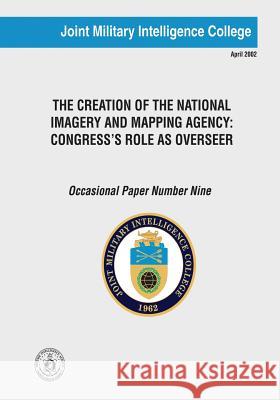The Creation of the National Imagery and Mapping Agency: Congress's Role as Overseer » książka
The Creation of the National Imagery and Mapping Agency: Congress's Role as Overseer
ISBN-13: 9781523654093 / Angielski / Miękka / 2016 / 122 str.
In October 2000, the National Imagery and Mapping Agency (NIMA) celebrated its fourth anniversary. That occasion marked a significant milestone for the newest member of the Intelligence Community. In the previous four years the leaders and people of NIMA had established an identity and culture for the agency and had defined and refined its vision and strategy. That is not to say that there are no more challenges for this organization. Like all government agencies, NIMA faces issues of downsizing and outsourcing, modernization, transformation and integration. However, in view of the agency's customer-sensitive plans for meeting these challenges, at the Agency's fourth annual customer conference General Henry H. Shelton, Chairman, Joint Chiefs of Staff, remarked, "NIMA has established itself as a key component in arming decisionmakers and operators with superior information and knowledge... NIMA's customer focus is the big reason that you've been such a success story in the four short years of your existence as a separate agency." During the spring and summer of 1995, I served as executive secretary of what was then known as the NIA (National Imagery Agency) Steering Group, as well as coordinator of various NIA Working Groups. I was in a unique position to observe the processes and politics that led to the decision to establish NIMA. Thereafter, I led the Integration Team during the implementation period from December 1995 until NIMA stand-up in October 1996. NIMA was formed from eight different agencies from throughout the Department of Defense and the Intelligence Community. At the outset, NIMA leadership decided that above all else, the quality and timeliness of service to customers would not fail during transition. This meant "protecting" imagery intelligence and mapping production processes from the bureaucratic blizzard of new policies and procedures that come with establishing a new organization (literally hundreds of policies had to be reviewed and either disestablished or modified, and the streamlining process still goes on today). But perhaps the most daunting task was to begin the process of creating a NIMA culture and identity. In December 2000, the congressionally-mandated independent NIMA Commission found that "NIMA is an essential component of U.S. national security and a key to information dominance." This agency has come a long way in a short time. But in December 1995, the future of this agency was dependent on the approval of the U.S. Congress. "The Creation of NIMA: Congress's Role as Overseer" provides an accurate and detailed look at the "behind the scenes" roles played by NIMA leaders, other members of the executive branch, and most interestingly, the role of the U.S. Congress and its various oversight committees. This paper provides government leaders and students of government with a primer on "how things get done" so that they may have a greater appreciation for the complex relationships within and between the executive and legislative branches.
Zawartość książki może nie spełniać oczekiwań – reklamacje nie obejmują treści, która mogła nie być redakcyjnie ani merytorycznie opracowana.











